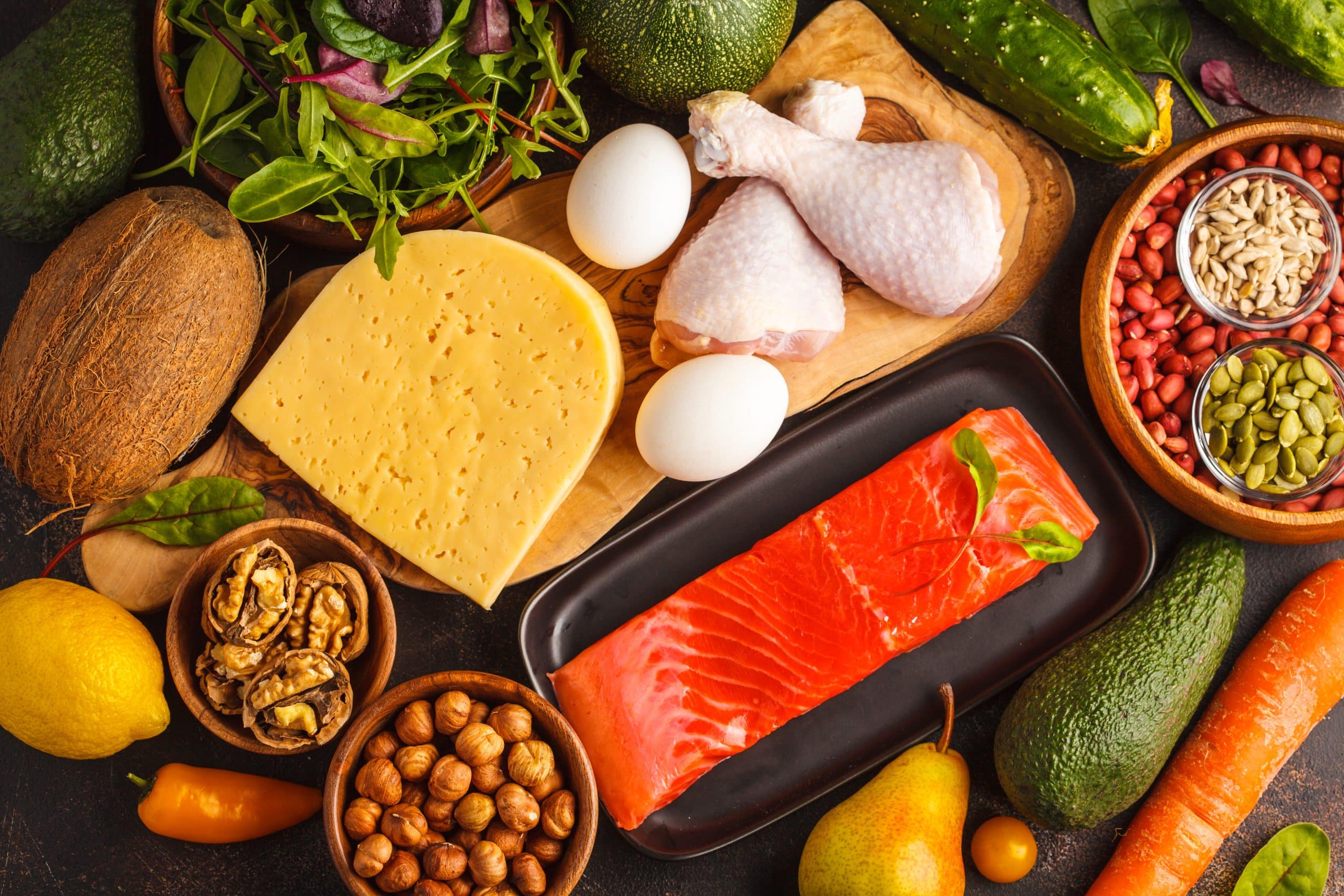Cheese is flavorful. Its texture can transform a meal from simple to sublime. If you’ve ever melted a slice of Gouda over a burger or sprinkled Parmesan on a pizza, you know exactly what we mean.
Let’s not forget that due to the strict macronutrient ratios of a keto diet, all food is under scrutiny. With this in mind, you may wonder whether or not your beloved cheese can still be on the table.
Truth is, many cheeses are perfectly compatible with the ketogenic lifestyle, being rich in both flavor and fat. Others, not so much.
Let’s explore which cheeses can be savored on a keto diet. We’ll also discuss how to incorporate them into your meals for both their health benefits and delectable taste.
Is Cheese a Carbohydrate or Protein?
Cheese is a good source of protein. It’s also rich in fat and contains varying amounts of carbohydrates, depending on the type. Almost all foods have more than one macronutrient, you may be surprised to find out that most vegetables have some protein and all legumes have carbs.
Here’s why we classify cheese as a protein source: it’s made from milk, which contains both protein and fat. Milk also contains carbohydrates, so cheese can have varying amounts of carbohydrates, mostly in the form of lactose (milk sugar) (4). However, many cheeses, especially harder and aged cheeses, have very low carbohydrate content, making their primary macronutrients protein and fat.
Let’s look at the cheese-making process to further understand how it affects its macronutrient composition (7) (9).
- Starting with Milk: Cheese begins its journey as milk, which is a rich source of both protein and fat. The type of milk (cow, goat, sheep) can influence the final cheese’s flavor and texture, but they all share a common high-protein starting point.
- Curdling: This process involves adding an acid (like lemon juice or vinegar) or rennet (an enzyme) to milk. This action causes the milk to separate into solids (curds) and liquid (whey). The curds are where most of the casein protein resides.
- Pressing and Aging: After curdling, the curds are pressed into molds and often aged. During this time, not only do the flavors develop, but the protein structure also changes, becoming more concentrated in the final product – cheese.
Reasons why BetterMe is a safe bet: a wide range of calorie-blasting workouts, finger-licking recipes, 24/7 support, challenges that’ll keep you on your best game, and that just scratches the surface! Start using our app and watch the magic happen.
Why Is Cheese Keto But Not Milk?
A 1-cup (8 fl oz) serving of milk contains about 12g of sugar (lactose) (6), which is a whopping amount for someone following strict keto macros. Cheese generally has less than 1g of sugar per serving, making it a more suitable choice for those following a keto diet.
Cheese is much lower in carbohydrates because of the curdling and aging process.
During the cheese-making process, most of the lactose is drained away with the whey. The little that remains in the cheese continues to break down over time, especially in aged cheeses, reducing the carbohydrate content even further.
So, while there are trace amounts of carbs in cheese, they’re minimal compared to the protein and fat content.
What Kind of Cheese Can I Eat on Keto?
Technically, any cheese can be eaten on a keto diet as long as it fits within your daily macronutrient goals. However, some cheeses are naturally lower in carbohydrates and higher in fat, making them more compatible with the keto lifestyle.
Here’s a list of the best cheese for keto:
Soft, Ripened Cheese
Soft-ripened cheeses, also known as “bloomy rind” cheeses, are a distinctive category in the cheese world characterized by their unique aging process and texture.
These cheeses are known for their creamy interior encased in a thin, edible rind that is often white or cream-colored and can sometimes appear slightly fuzzy. This rind develops due to the application of molds and cultures during the cheese-making process, which ripen the cheese from the outside in.
There are primarily two main types of soft-ripened cheeses: those with white “bloomy” rinds and those with “stinky” washed rinds.
The bloomy rind variety includes well-known cheeses like Brie and Camembert, which are celebrated for their mild flavors and creamy textures. In contrast, washed-rind soft-ripened cheeses carry more pungent aromas and flavors due to a different ripening process involving regular washing of the cheese surface.
Beyond their distinctive flavors and textures, these cheeses are also excellent options for a keto diet.
They have higher fat content and lower carbohydrate content compared to other types of cheese.
Here’s a list of soft, ripened cheeses that are keto-friendly (macronutrient breakdown per 1 slice or 1 oz/28g serving) (2):
Danish Blue Cheese (0.0g Net Carbs, 8.0g Fat, 6g Protein) – This cheese is known for its intensely sharp and salty flavor. It’s perfect for sprinkling over salads or adding a kick of flavor to keto-friendly burgers.
Brie (0.1g Net Carbs, 7.9g Fat, 5.9g Protein) – creamy and rich, Brie is good for spreading on keto-friendly crackers, added to a cheese platter or baked to create a gooey, delicious appetizer.
Camembert (0.1g Net Carbs, 6.9g Fat, 5.6g Protein) – Similar to Brie but with a deeper flavor, Camembert is excellent when served at room temperature with nuts or used in recipes like stuffed chicken for a creamy filling.
Goat Cheese (Soft) (0.2g Net Carbs, 7.2g Fat, 5.9g Protein) – Goat cheese is tangy and can be spread on keto-friendly bread, crumbled over salads, or used in sauces to add creaminess. It also comes in various flavors, like herbed or peppered, that adds more depth to dishes. Read labels to ensure the lowest carb options.
Roquefort Blue Cheese (0.6g Net Carbs, 8.7g Fat, 6.1g Protein) – This cheese is known for its sharp and tangy flavor profile, like the Danish blue cheese. Use it to add a punch of flavor to dishes or crumble over salads for a keto-friendly dressing.
Read more: Is Pho Keto? The Ultimate Guide to Enjoying Pho on a Low-Carb Diet
Hard, Aged Cheese
Hard, aged cheeses are a staple in many cuisines and are popular for their sharp, distinct flavors and long shelf life. These cheeses can be made from cow’s milk, goat’s milk, or sheep’s milk and are typically aged for a year or more to achieve their flavor profile.
These cheeses have lower moisture content, which means they’re more concentrated in protein and fat compared to soft-ripened cheeses.
Aging also helps break down the lactose, reducing the carbohydrate content even further. However, some hard, aged cheeses may have up to 3g of carbohydrates per serving, so it’s essential to check labels and stick to appropriate portion sizes.
Here are some hard, aged cheeses that are excellent for a keto diet (macronutrient breakdown per 1 slice or 1 oz/28g serving) (2):
Swiss Cheese (0.4g Net Carbs, 8.8g Fat, 7.6g Protein) – With its distinctive holes and mild, nutty flavor, Swiss cheese is perfect for layering in sandwiches made with keto-friendly bread or for adding a melt-in-your-mouth quality to burgers.
Provolone (0.6g Net Carbs, 7.6g Fat, 7.3g Protein) – This smooth, slightly sweet cheese is excellent for grilling or as a wrap for meats and veggies
Gouda (0.6g Net Carbs, 7.8g Fat, 7.1g Protein) – Smoked or traditional, Gouda’s rich, creamy texture and unique flavor make it a great addition to cheese platters or melted in keto quesadillas.
Cheddar (0.9g Net Carbs, 9.4g Fat, 6.5g Protein) – Cheddar cheese, known for its sharpness which increases with age, is versatile in the keto kitchen. It can be melted over vegetables for a quick side or used in omelets for a rich, flavorful breakfast.
Parmesan (0.9g Net Carbs, 7.0g Fat, 10.0g Protein) – Aged Parmesan, with its hard texture, is perfect for grating over salads, zoodles (zucchini noodles), or incorporating into keto-friendly pesto for a rich, nutty flavor.
Aged Asiago (0.9g Net Carbs, 8.0g Fat, 7.0g Protein) – This firm cheese is excellent for grating over vegetables or soups for added flavor or sliced thin for a hearty keto snack.
Pecorino Romano (1.0g Net Carbs, 9.0g Fat, 8.0g Protein) – Made from sheep’s milk, this cheese has a bold, salty flavor perfect for enhancing the taste of cooked greens or incorporated into keto-friendly carbonara.
Semisoft Cheese
Semisoft cheeses have a slightly softer texture and higher moisture content compared to hard, aged cheeses. They are known for their creamy, smooth consistency and can range from semi-firm to almost spreadable. These cheeses are often aged for a shorter amount of time, resulting in a milder flavor profile.
Here are some delicious semisoft cheeses that can be enjoyed on a keto diet (macronutrient breakdown per 1 slice or 1 oz/28g serving) (2):
Stilton (0.0g Net Carbs, 10.0g Fat, 7.0g Protein) – Known for its strong aroma and taste, Stilton can be crumbled over roasted vegetables or mixed into soups for a depth of flavor that compliments a keto diet
Monterey Jack (0.2g Net Carbs, 8.6g Fat, 6.9g Protein) – Monterey Jack’s mild flavor and meltability make it ideal for keto-friendly nachos made with low-carb tortilla chips, or for adding creaminess to spicy dishes.
Fontina (0.4g Net Carbs, 8.8g Fat, 7.3g Protein) – With its nutty and slightly sweet flavor, Fontina is versatile—melt it into a creamy sauce for zoodles, or use slices to elevate a keto-friendly chicken sandwich.
Havarti (0.8g Net Carbs, 9.0g Fat, 6.0g Protein) – With its buttery and slightly acidic taste, Havarti is excellent when melted in omelets or as a creamy addition to cold cuts for a satisfying keto lunch.
Mozzarella (1.0g Net Carbs, 5.0g Fat, 7.0g Protein) – Mozzarella is best known for its role in pizza and caprese salad. For a keto twist, use it to top cauliflower crust pizzas or layer it with tomato and basil for a refreshing snack.
Gorgonzola (1.0g Net Carbs, 8.0g Fat, 6.0g Protein) – This blue cheese variant is perfect for adding a bold, tangy flavor to keto salads or as a decadent topping for grilled steaks.
BetterMe app will provide you with a host of fat-frying fitness routines that’ll scare the extra pounds away and turn your body into a masterpiece! Get your life moving in the right direction with BetterMe!
Can You Over Eat Cheese on Keto?
It’s possible to overeat cheese on keto, especially when you eat varieties that are higher in carbs (such as cottage cheese, cream cheese, and ricotta). These cheeses typically have more than 1g of carbohydrates per serving, and if you’re not careful with portion sizes, it will add up quickly.
Even for varieties that are low in carbs, moderation is necessary for a few reasons:
Calorie Content
Most cheeses are high in calories due to their concentrated fat and protein content. While these macronutrients are essential for a keto diet, consuming too many calories can hinder weight loss efforts.
Be mindful of serving sizes and balance your cheese intake with other low-calorie, nutrient-dense foods like vegetables and lean proteins.
Type of Fat
Most cheeses contain an array of saturated and unsaturated fats. While saturated fat has been associated with an increased risk of heart disease, it has been suggested more recently that it may not be as harmful as previously thought (1).
That said, it’s essential to incorporate sources of healthy unsaturated fats such as olive oil, avocados, seeds and nuts, and omega-3 fatty acid-rich fish like salmon, tuna, and others into your diet to maintain a healthy balance.
Nutrient Balance
While cheese is a great source of fat and protein, it’s important to remember that a balanced keto diet also includes vegetables, healthy fats (like avocado or olive oil), and adequate hydration. Cheese alone cannot provide all the essential nutrients your body needs to function properly.
Potential for Dairy Intolerance
Some people may have a sensitivity or intolerance to dairy products, which can manifest in digestive issues like bloating, gas, or diarrhea (5). While this is usually related to an inability to digest lactose, the milk sugar which is typically very low in keto-friendly cheeses, if you experience any of these symptoms after consuming cheese or other dairy products on keto, it’s best to limit your intake and consult a healthcare professional for advice.
Read more: 6 Keto Sushi Recipes to Eat on a Low-Carb Diet
Philadelphia cream cheese isn’t the most keto-friendly cheese, as it contains about 2g of carbs per ounce (8). However, if you can fit it into your daily carb limit and enjoy it in moderation, there’s no harm in incorporating it into your meals. Look for recipes that use smaller amounts or consider using a lower-carb alternative like mascarpone or goat cheese. Feta cheese may be a good fit for a keto diet, as it has less than 1 gram of carbs per serving. However, like any other cheese, portion control is necessary to stay within your daily carb limit. Also, be mindful of the type and brand of feta cheese you are buying as some varieties may contain added ingredients that can increase the carb count. Parmesan cheese may be a good option for keto dieters, as it has less than 1 gram of carbs per serving. However, like any food on keto, moderation is key to staying within your daily carb limit. Also, be mindful of the type and brand of parmesan cheese you are buying as some varieties may contain added ingredients that can increase the carb count. Cream cheese contains about 1.6g of carbs per 28 gram serving (3). If you can fit it into your daily carb limit and enjoy it in moderation, there’s no harm in incorporating it into your meals. You can also consider using a lower-carb alternative like mascarpone or goat cheese to stay within your daily carb limit. Yes, tomatoes can be eaten on a keto diet in moderation. They are relatively low in carbohydrates and provide important nutrients like vitamin C and potassium. However, be mindful of portion sizes, as they do contain some carbs that can add up if you consume too much. It’s also important to factor in the carb content from any sauces or dishes that may contain tomatoes. Bacon can be a good option for keto dieters, as it is high in fat and protein. However, it’s essential to choose high-quality bacon that is free of added sugars and nitrates. Moderation is also key, as too much bacon can lead to an excessive calorie and saturated fat intake. It’s important to balance your bacon consumption with other nutrient-dense foods like vegetables and fruit. Mayonnaise is keto-friendly, as it’s high in fat and low in carbohydrates. Most commercial mayonnaise is made from ingredients like oil, egg yolks, and vinegar or lemon juice, all of which are suitable for a keto diet. However, be mindful of the brand you choose, as some may contain added sugars. You can also make your own mayonnaise at home using keto-approved ingredients like avocado oil or olive oil. Yogurt can be eaten on a keto diet, but it’s important to choose varieties that are low in carbohydrates and free of added sugars. Plain, unsweetened Greek yogurt is typically the best option, as it contains only about 5.7 g of carbs per 156 gram cup serving (10). Regular, plain full-fat yogurt can also work. However, be sure to check the nutrition label for any flavored or sweetened varieties as they may contain more carbohydrates. Be careful with low-fat, fat-free, and even 2% varieties as they tend to be higher in carbohydrates.FAQs
Is Philadelphia Cream Cheese Keto-Friendly?
Is Feta Cheese Keto?
Is Parmesan Cheese Keto-Friendly?
Can You Eat Cream Cheese on Keto?
Can I Eat Tomato On Keto?
Is Bacon Good for Keto?
Can I Have Mayo on Keto?
Can I Eat Yogurt On Keto?
The Bottom Line
Eating cheese on keto is possible and can provide a delicious source of fat and protein. However, it’s important to practice moderation and balance your cheese intake with other nutrient-dense foods. Be mindful of the type and brand of cheese you are consuming, as some varieties may contain added ingredients that can increase the carb count.
DISCLAIMER:
This article is intended for general informational purposes only and does not serve to address individual circumstances. It is not a substitute for professional advice or help and should not be relied on for making any kind of decision-making. Any action taken as a direct or indirect result of the information in this article is entirely at your own risk and is your sole responsibility.
BetterMe, its content staff, and its medical advisors accept no responsibility for inaccuracies, errors, misstatements, inconsistencies, or omissions and specifically disclaim any liability, loss or risk, personal, professional or otherwise, which may be incurred as a consequence, directly or indirectly, of the use and/or application of any content.
You should always seek the advice of your physician or other qualified health provider with any questions you may have regarding a medical condition or your specific situation. Never disregard professional medical advice or delay seeking it because of BetterMe content. If you suspect or think you may have a medical emergency, call your doctor.
SOURCES
- A short history of saturated fat: the making and unmaking of a scientific consensus (2022, ncbi.nlm.nih.gov)
- Carbs in Cheese List (n.d., ketovegetarianrecipes.com)
- Cheese, cream (2019, fdc.nal.usda.gov)
- Cheese (2020, hsph.harvard.edu)
- Lactose Intolerance, Dairy Avoidance, and Treatment Options (2018, ncbi.nlm.nih.gov)
- Milk, whole (2022, fdc.nal.usda.gov)
- Milk Production & Cheesemaking – Academy Of Cheese (n.d., academyofcheese.org) j
- PHILADELPHIA, CREAM CHEESE, ORIGINAL, ORIGINAL (2021, fdc.nal.usda.gov) g
- The Basics of Cheesemaking (2013, journals.asm.org)
- Yogurt, Greek, plain, nonfat (2019, fdc.nal.usda.gov)












